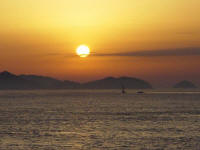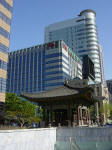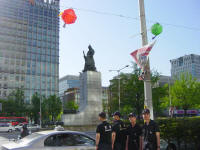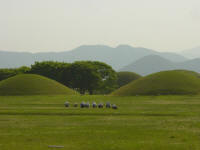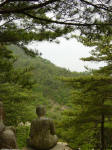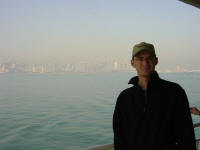|
KOREA
BEYOND DALIAN We were a bit nervous about our first holiday. Although we had been in China for two months, due to our work schedule we hadn’t yet ventured outside of Dalian and our Chinese was still limited to “I’d like rice.” Our ultimate holiday destination was South Korea, but we were first going to Dandong, a six-hour bus ride north of Dalian. From there, we would take a ferry to South Korea. A Chinese friend from school had helped us buy bus tickets to Dandong, reserve a cheap hotel room and book ferry tickets. But still, we worried about the effectiveness of communicating all of these transactions through sign language once we got there. Our last class before the holiday was our Friday night adult class. My students asked me where I was going to go, and I explained the trip. After class, King came up and said I couldn’t be taking a ferry from Dandong to South Korea because Dandong is on a river. I said I didn’t know how it worked, but the ticket was booked, so there must be a way. “Maybe you are going to North Korea,” he suggested. “That is just across the river from Dandong.” I told him it was impossible for me to go to North Korea. Just in case, I had Kelly translate some sentences into Chinese for me, such as, “Where is the ferry to Incheon?” (Incheon is the international port near Seoul, South Korea). After class, Zac introduced me to one of his students, Jerry, who had just come to his class for the first time that evening. It turned out that Dandong was Jerry’s hometown, and he was going there on Saturday as well, but on a different bus. He gave us his cell phone number and the address of his father’s restaurant in Dandong, and we were to call him from Dandong the next day. Our bus to Dandong left at 5:40 Saturday morning. All of the seats were full, but, reminiscent of Namibia, we still picked up more people along the way. Wherever there was a cluster of people by the road, the assistant would open the door and shout, “Dandong, Dandong, anyone going to Dandong?” Well, that’s what we assumed she was saying. Sometimes she would hop off to negotiate, and the driver would get annoyed, honk the horn incessantly and begin to pull away. The passengers we picked up on the roadside sat on plastic stools in the aisle. The ride was tedious since there wasn’t a major highway connecting the two cities. On the bus trip, we eagerly peered out of the windows, since it was our first view of the Chinese countryside. Even the rural areas of China were heavily populated. Every flat inch of land was a farm, and terraced fields climb up the slopes. Although it was drizzling, many people were out working in the muddy fields, doing all of the labor manually. Despite China’s booming economy, the farmers still remain incredibly poor. The annual income for a farmer is around 3,000 yuan, ($262), one-sixth that of the average urban dweller. We arrived in Dandong around noon on Saturday. The area had a population of 2.4 million, and the city seemed smaller than Dalian. It had a lot more bicycles and trees lining the streets though. A giant statue of Chairman Mao Zedong towered over the square in the center of town. We found our hotel by pointing at the sentence in my notebook that Kelly translated into Chinese, “Where is hotel Youdian Fandian?” The hotel seemed to be located in a construction zone. We checked in OK, ate some of the peanut butter and jelly sandwiches we’d packed, and attempted to call Jerry but could not properly operate the phone. In the hallway, we hailed one of the hotel workers, beckoned her to our phone, showed her the phone number, and she dialed. In a few minutes, Jerry met us in the lobby, and we took a taxi to his father’s restaurant. Not wanting to be a burden, we said we’d already eaten. Jerry was undeterred, and we went upstairs and the three of us were immediately served a five-course meal, including crabs, fish, beef, and fruit. That was lunch. Later that night, Jerry took us to his cousin’s hotel restaurant for supper. Jerry confessed that although he was majoring in biology, and planned to go to England to get his Ph.D. in biology, he really wanted to be a restaurant manager. Intent on being our tour guide, Jerry took us to the Yalu river so we could “watch North Korea” on Saturday afternoon. My students had told me that from Dandong you could see the North Koreans and that they were “very poor and dirty.” Unfortunately, it was too foggy from the rain to see across the river. Jerry said that at night Dandong was full of lights and noise, and the Korean side was dark and quiet. Jerry had been to North Korea so he told us about it as we walked along the river. He said you have to bring your own food because there are no stores there. The people get food cards and can collect food from the government. He said the area is a very good nature preserve, since there is no development and hardly even any farming. Jerry also said that you could get a bride for two bags of rice. I asked if the people seemed desperate to get out. He said no, because they don’t know anything. “They don’t have the internet. They don’t even have computers.” “What do they do in their spare time?” “I don’t know. I think they play traditional games, like that one where you go up and down.” “See-saw?” “Yes, that’s it.” I tried to imagine 24 million people see-sawing up and down in North Korea. We came to two bridges next to each other. One had a railroad on it and connected Dandong to Sinuijua, the town on the North Korean side of the river. We saw a train go across it, and Jerry said it was probably taking food to North Korea. The other bridge was the “Yalu River Broken Bridge” and went only half way across the river. We paid 15 yuan to walk on it. The bridge, constructed in 1909 by the Japanese during their occupation, was “broken” because the U.S. bombed it during the Korean war in 1950 to impede China’s support of North Korea. At the end of the bridge, we could see some twisted metal, but most of the damage had been removed. Jerry seemed disappointed—he said when he came here as a child the bridge was rusty and you could see more holes. It had since been repainted. We watched boats go under the bridge, and tried to peer through the fog that was concealing North Korea. We saw a group of people walk across the bridge from North Korea to China. Jerry asked, “Do you think North Korea has nuclear weapons?” I didn’t want to make any conjectures, and political questions are best answered with, “I don’t know” in China. Jerry said he thought they did. Well, I reasoned, China is probably the safest place we could be. On Sunday morning, Jerry took us to a Korean war museum, called The Museum to Commemorate US Aggression. In Chinese, the Korean war is known as “The war of resistance against America and in support of Korea.” In the entrance of the museum, near a large statue of Chairman Mao, a sign outlined China’s rationale for its involvement in the war. According to the museum, the U.S. imperialists wanted to occupy Korea and eventually the whole world and bullied the U.N. into supporting the war. China had to get involved in order to support the Korean people and restore peace and sovereignty to the peninsula. It was the most Since the day was clear, we went to the Yalu river again where we could see North Korea. The river was not very wide, and narrowed considerably upstream. Jerry said in the summer, the Koreans would swim in the river. “Don’t they try to swim to China?” He shook his head, no. But I wondered—it would be so easy. We took a speed boat ride nearly to the banks of North Korea. We couldn’t see much, since many boats lined the shore. But we waved and smiled to some North Koreans, who did look poor, but not that dirty. They all wore plain clothes with no color. I remembered one of my adult classes where they were supposed to contrast past and present China. One thing they had said was that in the past, everyone only wore dark clothes—black and grey. “But now,” they had said, “we wear many colors. Especially red.” FERRY TO INCHEON, SOUTH KOREA King was right. The ferry, although called Dandong Ferry, did not leave from Dandong. Its port was in Gangong, a town to the south of Dandong, where the Yalu river meets Korea Bay. Lucky for us, Jerry was able to sort everything out and find a bus from Dandong to Gangong, then a taxi to the ferry station. I’m not sure how we would have figured it out just using sign language. Jerry even came with us all the way to the terminal and made sure we got our tickets ok. Keep in mind we had only met him two days ago. At the gate, we thanked him profusely for all of his help, and he headed off to meet one of his cousins who lived nearby. Inside the terminal, there were several lines for departing from China. We guessed one was for Chinese and one for foreigners, although since most of the foreigners were Korean, we couldn’t tell the difference. We were mumbling to ourselves about this dilemma, when a voice in English said, “This line. Follow me.” A tall Korean took it upon himself to make sure we navigated all the lines correctly. Zac leaned against a pole to relax as the line didn’t seem to be moving. “Careful,” the tall Korean said, pulling Zac off the pole and brushing white paint dust from his black fleece. “China is dirty.” The ferry was small and there was no place to go except on deck or our small cubical style beds. We stayed on deck until the sunset and we were too cold, then retired to our beds to read. I had a restless night since a man near me snored quite loudly the whole time and I dreamt that Seoul had been attacked with nuclear weapons from North Korea. We arrived in Incheon Monday morning after an uneventful voyage. At the ferry terminal, we changed our Chinese Yuan into Korean Won and bought our return ferry tickets. Then we headed out to the street to look for the subway to Seoul, where we had booked a hostel for the night. We had no guidebook for South Korea and our internet research had turned up few details. But, we had the name and address of our hostel and as most people in South Korea speak English, that was all we really needed. Some men on the sidewalk told us there was no subway here, and we should take bus number 24 to get to Seoul. We got on the bus, and after a while, it occurred to us that we had no idea where to get off. We stayed on the bus for about an hour, waiting for something that looked right. I think we eventually came to the end of the route, because everyone got off the bus, so we did too. Our confusion must have been apparent, because a girl who got off at the same stop asked us if we needed help. She then directed us to the subway, which would take us into Seoul. On the way, I passed a stall selling waffles. Waffles don’t exist in China, and Zac and I hadn’t really eaten since Jerry took us to his family’s restaurants on Saturday. I bought the waffle and it was like heaven. We emerged from the subway near to where our hostel was supposed to be. We glanced around, trying to get our bearings when immediately a man in a business suit, speaking English, asked if we were lost. Of course we were. We showed him the directions to our hostel, but he couldn’t make sense of them either, so he just called the hostel on his cell phone and got directions. He said he was heading the same direction, so he got a taxi and took us to our hostel. Our whole time in South Korea was to be like that. Whenever we were lost of confused for more than two seconds, someone speaking English would magically appear and help us. We dropped our things off in our room, then headed back out to explore the city. We soon realized our hostel was located in the “home improvement” district. Imagine Lowe’s or Home Depot but in dozens of little shops. So our first impression of Seoul was a lot of bathtubs, floor tiles and ceiling lights. We were famished and in search of a restaurant. We finally found an area with lots of restaurants, but we weren’t prepared for how different Korean food was from Chinese. Nothing even looked good, and everything was expensive. So we ate at Pizza Hut. We eventually made it to the downtown area. We soon discovered that May 1st-5th was the Hi Seoul festival, so there were a few stages set up and the streets were lined with stalls selling food that looked very unappetizing to us. Seoul was the capital of the Joseon dynasty during the 15th century, and had many palaces dating to that period. I was disappointing to discover that most of them were rebuilt, having been destroyed by the Japanese. Seoul didn’t have the towering sky scrapers I was expecting, but it was consistently impressive. The city went on forever. Seoul has an urban population of nearly 10 million and was the largest city I’d ever been in. It seemed quite orderly and more westernized than Dalian. The main differences I noticed at first was that there were churches and that people religiously obeyed the cross-walk signs. In Dalian, people walk into oncoming traffic, but in Seoul the people didn’t walk until the sign was green, even if no cars were coming. Monday evening we watched a traditional music group at one of the festival stages. The performance was entertaining, but a bit confusing because at least one of the songs was in Spanish and I couldn’t figure out why. Later, we went to a different stage where people were performing songs from musicals such as Grease and The Sound of Music. That was also weird, because some of the songs were in English and some in Korean. The “Do, Re, Mi, Fa…” song was in Korean. Zac said, “But that wouldn’t make sense in Korean, would it?” On Tuesday, we took a bus around the city, visiting various sites such as Namdaemun Market, which dates back to the year 1414 and sells almost everything. It was interesting to look at the stalls and wonder why some shops were completely filled with American foods. Next we went to Yongsan Station, which was just a big train station with a mall on top. We also visited the Korean War Memorial and war museum. It was interesting to compare South Korea’s version of the war with China’s. South Korea didn’t claim to have won to war, but they did say that it was China who asked for an armistice, not vice-versa. There were maps showing how North Korea, armed by the Soviets, had taken almost the whole peninsula before the U.S. and the U.N. got involved. Then the maps showed that most of the peninsula was in South Korean control until China got involved. The rest is history, I guess. The South Koreans wear colorful clothes and the North Koreans don’t. After the war museum, we took a bus to the top of a hill in the center of town with views of the whole city. The best part about Seoul is that there are so many hills in and around the city that despite all the buildings, there are still many beautiful natural areas. I was amazed at the vastness of the city. I doubted that Pyongyang looked anything like this. On Wednesday, we took a bus 365 km southeast to Gyeongju, the capital of the ancient kingdom of Silla, which controlled most of the Korean Peninsula from the1600s to the 1800s. It is also listed as one of the world’s ten most important ancient cultural cities. To me, it just looked like a town with a bunch of grass mounds everywhere and the traditional Korean architecture. Although I had the names of 4 hostels in Geyongju, the girl at the tourist office had never heard of them and recommended we try one of the hotels nearby since they were cheap. Now, Zac and I don’t care to much about comforts and were more concerned about making our Chinese salary survive a week of Korean prices (costs were at least double and sometimes even ten times as expensive as in China). Therefore, we looked for the worst hotel, thinking it would be the cheapest. “Here, this lobby is dark, let’s try this one.” We walked in and spoke some English to a lady behind the desk who clearly didn’t understand us. Somehow, we communicated our intents and she gave us a key and led us to our room. The room was nice. She left. I turned to Zac, “Don’t you think it’s a bit odd we didn’t have to sign in or show our passports or pay?” A few minutes later, another woman appeared at our door asking for money. We paid the 50,000 won ($50) for the two nights and she left. I turned to Zac, “She didn’t give us a receipt. Maybe we just gave all that money to the cleaning lady or something.” That afternoon, we visited some palaces and tombs and a pond made during the Silla unification period. We ate tradition Korean ramen noodles for supper at a noodle shop near the bus station. For dessert, we bought some Gyeongju Traditional Bread because there were so many shops advertising it, but we had no idea what it was. Gyeongju Traditional Bread turned out to be small pancakes. Thursday morning we went to Mount Namsan or “South Mountain” near Gyeongju. The mountain was said to be a “museum without walls” because of all the ancient stone Buddhas carved on the mountain. We found out which bus to take, but as usual, we didn’t know where to get off. A group of older men with day-packs and trekking sticks got on the bus, so we sat back and relaxed, figuring we’d get off whenever they did. Finally, at one stop, the bus driver came back and said something to us in Korean. We replied, “Mt. Namsan.” He gestured to the door, so we got off there, and found a path up the mountain. Thursday was May 5th, which is celebrated as Children’s Day in South Korea. It was a public holiday, and as the weather was good, everyone else had apparently also decided to visit the Buddhas on the Mt. Namsan. The mountain was beautiful. Although in Dalian the trees were just budding, the Korean spring was more advanced, and the foliage was abundant. We spent the whole day on the mountain, enjoying exercise and fresh air, spectacular views, squirrels with funny ears, and devout Koreans bowing to the forest Buddhas. The mountain was crisscrossed with numerous paths, all the signs were in Korean, so despite our map, we were generally lost the whole time. Yet we still managed to stumble across a decent amount of Buddhas. There was something quite exhilarating about hiking through the fresh green forest and coming upon a thousand-year-old Buddha, just as serene as ever, sitting on top of a mountain peak. We returned to Gyeongju in the evening, just as it was beginning to rain. We ate traditional Korean ramen noodles again, and bought some ice-cream at the grocery store. We returned to our hotel room to watch CNN repeat the story again and again about how there was an explosion in front of the British consulate in New York, and, oh yeah, a bunch of people got blown up in Iraq again. We ate our ice-cream and I thought of the mountain Buddhas. Friday we checked out of our hotel by merely returning the key to the front desk. (Were we ever really checked in?) We put our large backpack into a locker at the bus station and walked to the Gyeongju museum, where there were numerous artifacts from the Silla dynasty, including many more stone Buddhas. Zac commented that no one was bowing to the Buddhas in the museum like they had on the mountain. “Maybe there are just too many,” he suggested. I looked around at the museum walls. Maybe the mountain made a better temple. GYEONGJU TO SEOUL TO INCHEON TO DALIAN Friday afternoon, we took a bus back to Seoul. The Korean countryside was very hilly and beautiful, with neat fields covering all of the flat land. They had farm machinery to plow the fields and no one was out working in the rain. In fact, the whole country looked similar to the U.S. when compared with China. There were major highways connecting the cities, and the buses did not have to swerve around bicycles and carts. Once in Seoul, we returned to the same hostel, but only after eating at Pizza Hut again. On Saturday morning, we visited the Seoul museum of history, which was surprisingly small and we managed to cover it in an hour. Then we ate lunch at McDonalds. Saturday afternoon we took the subway to Incheon, then a bus to the ferry station. We boarded our ferry for Dalian, which was much bigger than the Dandong ferry. It actually had a lounge where you could sit. Since we nearly starved to death on our first ferry ride, we came prepared this time with our buckets of ramen noodles (just add hot water). I didn’t sleep well again, since the man in the bunk above me was snoring quite loudly the whole night. But alas, Sunday morning we arrived in Dalian. As soon as we made it through customs, we went to a restaurant just outside the station and ordered our favorite Chinese dish, even although it was only 10 a.m. It was good to be back home again. click here for more pictures of Dandong and Seoul and Gyeongju and Mt. Namsan
|
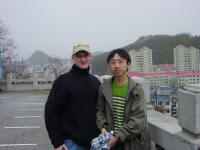
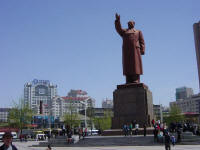
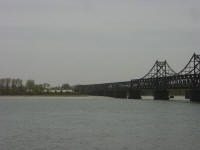
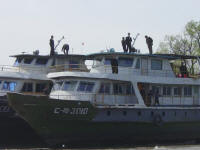 interesting museum. To give you a taste of China’s version of events, let me quote one sign. “From October 1950 to June 1951, the Chinese People’s Volunteers waged five battles continuously together with the Korean People Army and annihilated more than 230,000 enemies. The aggressors were hit back to the 38th parallel from the Yalu River and the battle line was stabilized at the 38th parallel area. The U.S. imperialists were forced to hold armistice talks, which laid a solid foundation for the victory of the Korean War.” The theme of the museum was really about how China defeated the U.S. and saved Korea. North Korea won the war.
interesting museum. To give you a taste of China’s version of events, let me quote one sign. “From October 1950 to June 1951, the Chinese People’s Volunteers waged five battles continuously together with the Korean People Army and annihilated more than 230,000 enemies. The aggressors were hit back to the 38th parallel from the Yalu River and the battle line was stabilized at the 38th parallel area. The U.S. imperialists were forced to hold armistice talks, which laid a solid foundation for the victory of the Korean War.” The theme of the museum was really about how China defeated the U.S. and saved Korea. North Korea won the war.